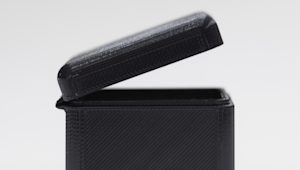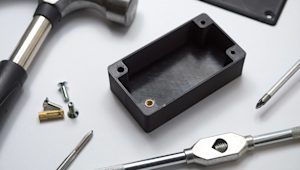Design Something For 3d Printing
Key design considerations for 3D printing
A list of things to keep in mind when designing a model for 3D printing - regardless of the technology that you will be printing with.
General Design Consideration for 3D Printing
Overhangs
All 3D printing processes build parts layer-by-layer. Material cannot be deposited onto thin air, so every layer must be printed over some underline material
Overhangs are areas of a model that are either partially supported by the layer below or not supported at all. There is a limit on the angle every printer can produce without the need of support material. For example, for FDM and SLA this angle is approximately 45o degrees.
It is a good practice to limit the overhangs of a model, as layers printed over support usually have a rougher surface finish.

Wall thickness
The second thing to keep in mind when designing a part to be 3D printed is wall thickness. Every 3D printing process can produce accurately features that are thin up to a certain point.
For example, imagine you are an engineer who designs hang gliders for a living. You have come up with a great, new design that you have decided to 3D print scaled down for testing. 3D modeling programs allow you to model the sailcloth of the wing, but you would encounter problems when you would try to 3D print it, as its thickness would be extremely small.
As a good practice, always add thickness to your models. Walls with thickness greater than 0.8 mm can be printed successfully with all processes.
Warping
Something that is often easily overlooked while designing a 3D model is the fact that the materials used for 3D printing undertake physical change: they are melted, sintered or scanned with a laser and solidified. The heating and cooling of material can cause the parts to warp while printing.
Large, flat surfaces can be especially prone to warping. Warping can typically be avoided by using correct machine calibration and having adequate surface adhesion between your part and the print bed. Your Hub will be able to offer more advice on design techniques that can be used to minimize the likelihood of warping.
A good practice is to avoid large flat surfaces and add rounded corners to your 3D models.

Level of detail
When you are creating a 3D model with intricate details, it is important to keep in mind what is the minimum feature size each 3D printing process can produce. The minimum level of detail is connected to the capabilities and mechanics of each 3D printing process and to the selected layer height.
The process and materials used will have an impact on the speed and cost of your print, so determining whether smaller details are critical to your model is an important design decision.

More resources for engineers

The importance of designing draft angles for injection molding
Learn why draft angles for injection molded parts are a required feature, as well as design considerations and tips in order to design them correctly.
Read article

How to design parts for injection molding
A complete guide to Injection Molding with basic & advanced design tips, including design guidelines for snap-fits, living hinges, undercuts and surface finishes.
Read article

How to design parts for binder jetting 3D printing
A comprehensive guide on designing parts for Binder Jetting, covering the printing process, design specifications and material options.
Read article

How to design parts for material jetting 3D printing
This article explains how to design Material Jetting 3D printed parts including technical design specifications, materials, limitations and an introduction into the post-processing options available.
Read article

How to design parts for metal 3D printing
A comprehensive guide for metal 3D printing covering the printing process, design specifications, material options and technology limitations.
Read article

How to design living hinges for 3D printing
This article discusses the advantages of living hinges and present-day design rules and material recommendations when using 3D printing to produce living hinges.
Read article

How to design parts for SLS 3D printing
This article discusses how to design SLS 3D printed parts including technical design specifications, materials, limitations and an introduction into the post-processing options available.
Read article

Selecting the optimal shell and infill parameters for FDM 3D printing
Shell and infill properties impact the performance and cost of FDM 3D printing. Learn how to optimize these features for your 3D printed part
Read article

How does part orientation affect a 3D print?
This article discusses the impact part orientation has on the accuracy, strength, speed and surface finish of 3D printed parts.
Read article

The impact of layer height on a 3D print
Learn about the importance of layer height and how it affects the quality, appearance and strength of 3D printed parts
Read article

3D printing geometry restrictions
Learn about how large a 3D print can be along with how element thickness, watertightness, and curved surfaces affect the quality of a print.
Read article

How to assemble 3D printed parts with threaded fasteners
Compare different methods for creating threads in your parts and follow step-by-step instructions on how to install your fasteners.
Read article

The importance of designing draft angles for injection molding
Learn why draft angles for injection molded parts are a required feature, as well as design considerations and tips in order to design them correctly.
Read article

How to design parts for injection molding
A complete guide to Injection Molding with basic & advanced design tips, including design guidelines for snap-fits, living hinges, undercuts and surface finishes.
Read article

How to design parts for binder jetting 3D printing
A comprehensive guide on designing parts for Binder Jetting, covering the printing process, design specifications and material options.
Read article

How to design parts for material jetting 3D printing
This article explains how to design Material Jetting 3D printed parts including technical design specifications, materials, limitations and an introduction into the post-processing options available.
Read article

How to design parts for metal 3D printing
A comprehensive guide for metal 3D printing covering the printing process, design specifications, material options and technology limitations.
Read article

How to design living hinges for 3D printing
This article discusses the advantages of living hinges and present-day design rules and material recommendations when using 3D printing to produce living hinges.
Read article

How to design parts for SLS 3D printing
This article discusses how to design SLS 3D printed parts including technical design specifications, materials, limitations and an introduction into the post-processing options available.
Read article

Selecting the optimal shell and infill parameters for FDM 3D printing
Shell and infill properties impact the performance and cost of FDM 3D printing. Learn how to optimize these features for your 3D printed part
Read article

How does part orientation affect a 3D print?
This article discusses the impact part orientation has on the accuracy, strength, speed and surface finish of 3D printed parts.
Read article

The impact of layer height on a 3D print
Learn about the importance of layer height and how it affects the quality, appearance and strength of 3D printed parts
Read article

3D printing geometry restrictions
Learn about how large a 3D print can be along with how element thickness, watertightness, and curved surfaces affect the quality of a print.
Read article

How to assemble 3D printed parts with threaded fasteners
Compare different methods for creating threads in your parts and follow step-by-step instructions on how to install your fasteners.
Read article
Design Something For 3d Printing
Source: https://www.hubs.com/knowledge-base/key-design-considerations-3d-printing/
Posted by: carpenterhices1941.blogspot.com

0 Response to "Design Something For 3d Printing"
Post a Comment